
Pinellas County is located on the west central coast of the state of Florida. As of the 2020 census, the population was 959,107. The county is part of the Tampa–St. Petersburg–Clearwater, Florida Metropolitan Statistical Area. Clearwater is the county seat. St. Petersburg is the largest city as well as the largest city in Florida that is not a county seat.

St. Petersburg is a city in Pinellas County, Florida, United States. As of the 2020 census, the population was 258,308, making it the fifth-most populous city in Florida and the second-largest city in the Tampa Bay Area, after Tampa. It is the largest in the state that is not a county seat. Along with Clearwater, these cities are part of the Tampa–St. Petersburg–Clearwater Metropolitan Statistical Area, the second-largest in Florida with a population of around 2.8 million. St. Petersburg is on the Pinellas peninsula between Tampa Bay and the Gulf of Mexico, and is connected to mainland Florida to the north.

Clearwater is a city located in Pinellas County, Florida, United States, northwest of Tampa and St. Petersburg. To the west of Clearwater lies the Gulf of Mexico and to the southeast lies Tampa Bay. As of the 2010 census, the city had a population of 107,685. Clearwater is the county seat of Pinellas County and is the smallest of the three principal cities in the Tampa–St. Petersburg–Clearwater metropolitan area, most commonly referred to as the Tampa Bay Area.

Dunedin is a city in Pinellas County, Florida, United States. The name comes from Dùn Èideann, the Scottish Gaelic name for Edinburgh, the capital of Scotland. Dunedin is part of the Tampa-St. Petersburg-Clearwater metropolitan area and is the 5th largest city in Pinellas County. The population was 35,321 at the 2010 census.

Largo is the third largest city in Pinellas County, Florida, United States as well as the fourth largest in the Tampa Bay area. As of the 2010 Census, the city had a population of 77,648, up from 69,371 in 2000.

Pinellas Park is a city located in central Pinellas County, Florida, United States. The population was 53,093 at the 2020 census. Originally home to northern transplants and vacationers, the hundred year old city has grown into the fourth largest city in Pinellas County, the most densely-populated county in Florida. The city and surrounding areas are almost completely urbanized. Pinellas Park contains a substantial portion of the Gateway area of the county, targeted for future infrastructure, residential, and commercial development as it sits roughly in the middle of the Tampa Bay area's over two million people. Though land-locked, its borders lie only a few miles from Tampa Bay to the east, and Boca Ciega Bay and the Gulf of Mexico to the west. The city is known for its popular equestrian facilities and events, and many residents also participate in fishing and water activities in nearby venues.
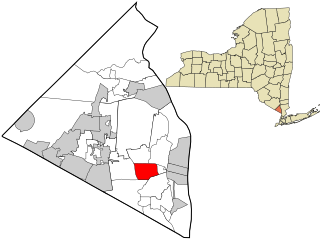
West Nyack is a hamlet and census-designated place in the town of Clarkstown, Rockland County, New York, United States. It is located north of Blauvelt, east of Nanuet, southwest of Valley Cottage, southeast of Bardonia, and west of Central Nyack. It is approximately 18 miles (29 km) north of New York City. The population was 3,439 at the 2010 census.

Jones Point is a geographic point on the Potomac River within the city of Alexandria, Virginia, United States. The Jones Point Light and Jones Point Park are located at the point, which is immediately North of the confluence of Hunting Creek and the Potomac River. The 1791-1792 survey of the original boundaries of the District of Columbia began at a spot that was then at the tip of a cape at the Point. The south cornerstone from the boundary survey remains in a seawall several yards south of the lighthouse.

The Garden District is a neighborhood of the city of New Orleans, Louisiana, United States. A subdistrict of the Central City/Garden District Area, its boundaries as defined by the New Orleans City Planning Commission are: St. Charles Avenue to the north, 1st Street to the east, Magazine Street to the south, and Toledano Street to the west. The National Historic Landmark district extends a little farther.
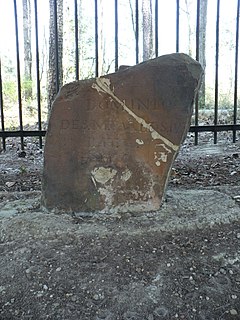
Ellicott's Stone, also known as the Ellicott Stone, is a boundary marker in northern Mobile County, Alabama. It was placed on April 10, 1799 by a joint U.S.-Spanish survey party headed by Andrew Ellicott. It was designated as a National Historic Civil Engineering Landmark in 1968 and was added to the National Register of Historic Places on April 11, 1973.
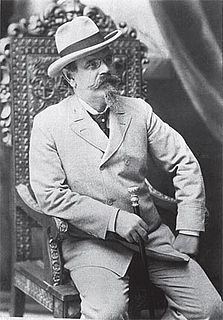
Peter Demens born Pyotr Alexeyevitch Dementyev was a Russian nobleman, who migrated in 1881 to the United States and became a railway owner and one of the founders of the U.S. city of St. Petersburg, Florida.
State Road 694 (SR 694) is an east–west route in Pinellas County, running from SR 693 in Pinellas Park to U.S. Route 92 in St. Petersburg.

The Jungle Prada Site is an archaeological site featuring Indigenous Tocobaga mounds and the location of the historical Narváez expedition landing. The Jungle Prada site spans public and private property, including the Jungle Prada de Narvaez city park, in St. Petersburg of Pinellas County, western coastal Florida, in the Southern United States.
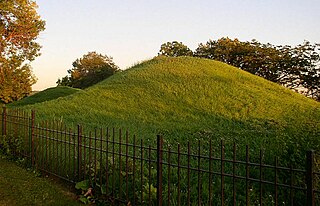
Indian Mounds Regional Park is a public park in Saint Paul, Minnesota, United States, featuring six prehistoric Native American burial mounds overlooking the Mississippi River. The oldest mounds were constructed 1,500–2,000 years ago by people of the Hopewell tradition. Later the Mdewakanton Dakota people interred their dead there as well. At least 31 more mounds were destroyed by development in the late 19th century. They were the tallest Native American mounds in Minnesota and Wisconsin, and comprise one of the northwesternmost Hopewellian sites in North America. Indian Mounds Regional Park is a component of the Mississippi National River and Recreation Area, a unit of the National Park System. The Mounds Group is listed on the National Register of Historic Places. The 2014 nomination document provides a description of the archaeology and the context.
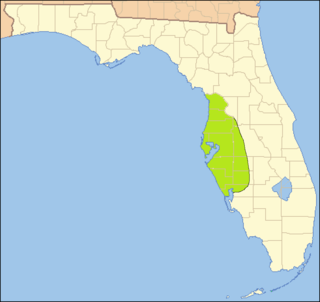
The Safety Harbor culture was an archaeological culture practiced by Native Americans living on the central Gulf coast of the Florida peninsula, from about 900 CE until after 1700. The Safety Harbor culture is defined by the presence of Safety Harbor ceramics in burial mounds. The culture is named after the Safety Harbor Site, which is close to the center of the culture area. The Safety Harbor Site is the probable location of the chief town of the Tocobaga, the best known of the groups practicing the Safety Harbor culture.
Leavenworth is an unincorporated community located in Leavenworth Township in Brown County, Minnesota, United States. The elevation is 1,004 feet. It was situated on two locations in Brown County, one before the Dakota War of 1862, and in section 27 of the township along the Cottonwood River after the war.

Quihi is a settlement in Medina County, in the U.S. state of Texas. Located 9 miles (14 km) north of Hondo, it sits at the intersection of Farm to Market Road 2676 and Quihi Creek. In 1936, Quihi received centennial marker Number 5537, a gray granite marker placed to commemorate the Texas Centennial.

This is a timeline of the U.S. state of Florida.

Colonial Dorchester State Historic Site sits along the Ashley River, near the town of Summerville in Dorchester County, South Carolina. In 1969, the site was donated to the South Carolina State Park Service and was added to the National Register of Historic Places on December 2, 1969. Currently the site of a 325-acre park, Old Dorchester State Park offers visitors a glimpse into South Carolina's Colonial past. The park boasts one of the most well-preserved oyster-shell tabby forts in the country, St. George's Bell Tower, log shipping wharves, burial sites and cemeteries, as well as on-going archaeological digs that are still unearthing the settlement's history.
Juan Ortiz was a Spanish sailor who was held captive by Native Americans in Florida for eleven years, from 1528 until he was rescued by the Hernando de Soto expedition in 1539. Two accounts of Ortiz's eleven years as a captive, differing in details, offer a story of Ortiz being sentenced to death by a Native American chief two or three times, saved each time by the intervention of a daughter of the chief, and finally escaping to a neighboring chiefdom, whose chief sheltered him.

















